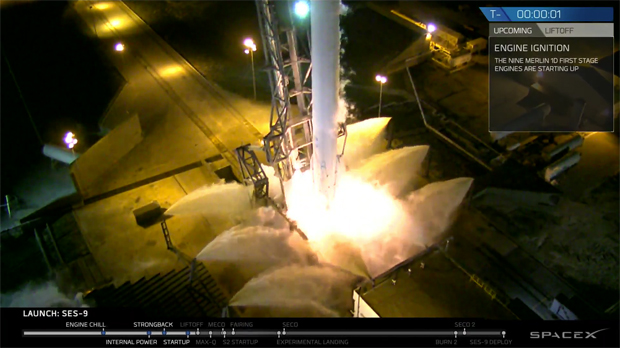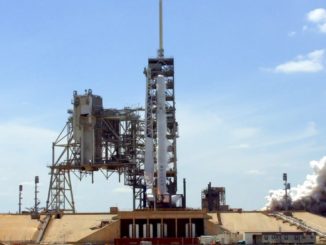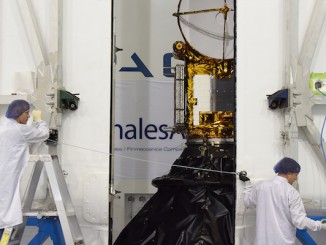
A commercial communications satellite stayed on Earth after a last-second launch abort Sunday, the third time in five days that SpaceX has scrubbed the launch of a Falcon 9 rocket from Cape Canaveral.
Sunday’s countdown got closer to launch than the rocket’s earlier tries, coming within a moment of liftoff before computers detected a problem and aborted the flight at engine start.
SpaceX did not set a new date for the launch of the SES 9 communications satellite, but the U.S. Air Force’s 45th Space Wing — owner of the Cape Canaveral launch range — indicated the flight would not take off until at least Tuesday.
“The range will begin evaluating new launch dates from the customer no earlier than 48 hours” from Sunday, the Air Force said in a statement.
SpaceX’s launch team aimed to have the 229-foot-tall rocket ready for takeoff at 6:47 p.m. EST (2347 GMT), but Air Force range safety officials ordered a hold in the countdown less than two minutes before liftoff.
A boat strayed into restricted waters downrange from Cape Canaveral, and a military helicopter scrambled to chase the vessel out of the keep-out zone.
Engineers set up for another try at launching at 7:21 p.m. EST, and the countdown appeared to go smoothly, with the Falcon 9’s propellant tanks pressurizing and its nine Merlin 1D first stage engines firing up seconds before launch.
But the engines went quiet with a flash of green-orange light a moment after ignition, and SpaceX’s launch director officially called off Sunday’s launch attempt a few minutes later.
Spaceflight Now members can see a video clip of Sunday’s last-second abort as seen from a press viewing site a few miles away.
Elon Musk, SpaceX’s founder and chief executive, posted an update on Twitter shortly after the last-second abort.
“Launch aborted on low thrust alarm,” Musk tweeted. “Rising oxygen temps due to hold for boat and helium bubble triggered alarm.”
The launch of SES 9 is the second flight an upgraded, or “full-thrust,” version of SpaceX’s Falcon 9 booster.
The uprated rocket stands five feet taller than the previous Falcon 9 configuration, and it burns a super-chilled mixture of RP-1 kerosene and liquid oxygen propellants. The fuel mix is cooled up to 50 degrees lower than usual — down to minus 340 degrees in the case of the cryogenic liquid oxygen — to densify the liquids closer to their freezing points.
The extra refrigeration allows more propellants to be loaded into the Falcon 9’s fuel tanks, and the fuel flows faster into the rocket’s engines, resulting in higher thrust.
The changes give the Falcon 9 the ability to lift 30 percent more mass into orbit, according to SpaceX, and also permits more opportunities to recover rocket boosters for reuse.
But the super-chilled propellants come with handling difficulties, and SpaceX adjusted its countdown procedures to fuel the Falcon 9 rocket a half-hour before liftoff — instead of several hours in advance — to give the densified liquids less time to warm up before liftoff.
SpaceX scrubbed a launch attempt Wednesday before fueling because the liquid oxygen was not cold enough. On the Falcon 9’s second try Thursday, the launch team ran into problems loading liquid oxygen into the two-stage rocket and stopped the countdown inside T-minus 2 minutes.
Then the Falcon 9’s liquid oxygen load got too warm Sunday while waiting for the Air Force to clear the range.
The 11,620-pound (5,271-kilogram) SES 9 telecom satellite poised for launch on top of the Falcon 9 rocket is starting a 15-year mission to broadcast television services over the Asia-Pacific and link ships in the Indian Ocean.
The Boeing-built craft is the second payload from SES — a large Luxembourg-based satellite operator — to launch on a SpaceX Falcon 9.
SES 9 was supposed to launch last year, but a Falcon 9 launch failure in June 2015 prompted more than six months of delays.
Email the author.
Follow Stephen Clark on Twitter: @StephenClark1.



